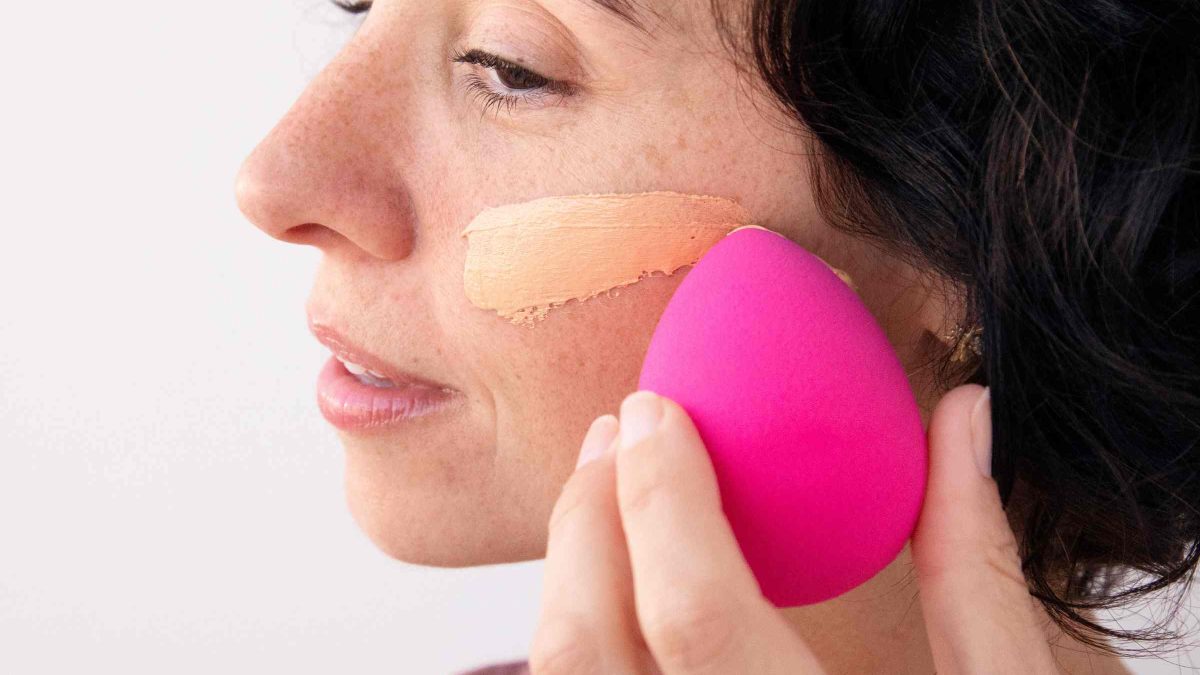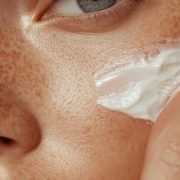How to Use a Makeup Sponge for the Best Application
Posted on April 16, 2025 Written by: 100% PURE®

When it comes to using a makeup sponge, the ultimate question is: should it be wet or dry? The answer isn’t one-size-fits-all—it depends on what product you’re applying, your skin type, and the finish you want to achieve.
A damp sponge is your go-to for a dewy, natural look, blending everything seamlessly. On the flip side, a dry sponge offers fuller coverage, perfect for those days when you want a more polished finish.
Enter the .—this versatile tool is made to work beautifully with both methods, giving you the flexibility to achieve any look with ease and a .
Benefits of Using a Damp Makeup Sponge
If you’re aiming for that flawless, lit-from-within finish, using a damp makeup sponge is one of the simplest ways to upgrade your makeup routine. Whether you have dry skin, love a dewy look, or want to save on foundation, here’s why damp is the way to go:
1. Prevents Product Absorption
When you use a dry sponge, it tends to soak up a lot of your foundation or concealer, meaning more product is wasted than applied. A damp sponge, on the other hand, has already absorbed water, so it doesn’t absorb as much product. That means more coverage and less waste.
Perfect for:
Liquid foundations
Cream blushes and bronzers
Concealers
Recommended Product
– This lightweight, serum-like foundation melts into your skin and offers a breathable, second-skin finish. When applied with a damp sponge, you’ll get even distribution with minimal product loss.
2. Creates a Natural, Sheer Finish
A damp sponge diffuses the product gently across the skin, giving you that soft, airbrushed look. It’s ideal for anyone who wants their rather than makeup. The moisture in the sponge helps spread the product evenly without streaking or caking.
Perfect for:
Everyday, no-makeup makeup looks
Natural glam
Dewy, youthful skin goals
Recommended Product
(again!) – Its silky texture combined with a damp sponge gives you a fresh, skin-like finish that lasts all day.
3. Smooth Application for Dry or Flaky Skin
If your skin is dry or textured, makeup can cling to problem areas and highlight imperfections. A damp sponge delivers hydration as you apply, smoothing foundation over dry patches for a more even, radiant look.
Perfect for:
Cold weather routines
Dry or mature skin types
Hydrating base products
Recommended Product
– This primer is infused with skin-loving botanicals and radiance-boosting pigments. Layer it with a damp sponge to prep and plump the skin before foundation.
4. Best for Liquid and Cream Products
Damp sponges are ideal for blending creamy formulas like foundation, concealer, blush, and highlighter. They prevent heavy application and help your makeup melt into the skin, avoiding cakey or heavy results.
Perfect for:
Cream bronzers
Liquid highlighters
BB and CC creams
Recommended Product
– This ultra-hydrating BB cream provides light coverage, sun protection, and nourishing benefits. A damp sponge makes it even easier to blend for that glowy, hydrated finish.
Pro Tip: After soaking your sponge, make sure to squeeze out the excess water—it should be damp, not dripping. For even more glow, try misting it with a facial toner or rosewater spray before blending!

Benefits of Using a Dry Makeup Sponge
While damp sponges are perfect for a , dry makeup sponges offer their own unique advantages—especially when you’re aiming for full coverage, oil control, or a matte finish. Here’s when and why you should reach for a dry sponge instead:
1. Provides Full-Coverage Application
A dry sponge doesn’t dilute your product the way a damp one does, so you’ll get maximum pigment payoff and more concentrated coverage. This makes it a go-to for covering acne scars, redness, and hyperpigmentation without having to layer too much.
Perfect for:
Full glam looks
Concealing blemishes
Building flawless base coverage
Recommended Product
– This rich, full-coverage formula glides smoothly over the skin and works beautifully with a dry sponge for maximum coverage with a flawless finish.
2. Ideal for Powder Products
Dry sponges are excellent at picking up and pressing powder-based products into the skin. This technique helps lock in makeup, reduce shine, and create a long-lasting matte finish—without looking cakey.
Perfect for:
Setting powders
Powder foundation
Touch-ups on the go
Recommended Product
– For precise coverage of dark circles or blemishes, apply this concealer with a dry sponge to build intensity and lock it in with powder.
3. Controls Oil and Shine
Since dry sponges don’t introduce any extra moisture to the skin, they’re especially useful for oily or combination skin types. They help absorb excess oils and can be used throughout the day to blot and refresh your makeup.
Perfect for:
Midday touch-ups
Reducing T-zone shine
Keeping makeup matte and intact
Pro Tip: Blot your skin with a clean, dry sponge instead of tissue or blotting paper. It’ll mattify without disturbing your makeup.
Professional Makeup Artist Consensus
Many professional makeup artists using a slightly damp sponge for applying liquid and cream products. Dampening the sponge helps in blending these formulations seamlessly, resulting in a natural, dewy finish. The sponge should be expanded but not soaking wet for optimal performance. This technique minimizes product absorption by the sponge, ensuring more product stays on the skin.
For powder-based products, it’s advisable to use a dry sponge. A dry sponge allows for precise application and helps in pressing the powder into the skin, setting the makeup effectively, and avoiding clumping. This method ensures a smooth, matte finish without excess product buildup.
To keep your sponge performing at its best, make sure to —ideally after each use. A clean not only ensures smoother application but also protects your skin from unwanted breakouts or irritation.
How to Properly Use a Makeup Sponge
|
Damp Sponge |
Dry Sponge |
|---|---|
|
To use a damp sponge, run it under water until fully expanded, then squeeze out any excess water. The sponge should feel slightly damp, not soaking wet. For best results, bounce the sponge against your skin rather than dragging it, ensuring even blending of your foundation or cream products for a smooth, flawless finish. |
A dry sponge works best with powder products or full-coverage foundations. Simply dab, press, or roll the sponge onto your skin for precise application and seamless coverage, allowing you to build and set your makeup without any clumping. |
Caring for Your Makeup Sponge
It’s important to clean your makeup sponge after each use to prevent bacteria buildup. Use a gentle cleanser or micellar water to remove product residue and keep your sponge in top condition.
– A non-stripping, natural solution for effectively cleansing makeup sponges while maintaining their softness and integrity.

Best Makeup Sponge To Add In Your Beauty Routine
For a natural, sheer finish with liquid or cream foundations, use a damp sponge. A dry sponge is perfect for full coverage and powder products, ensuring a smooth, matte finish.
If you want to buy a blender that works great for both wet and dry applications, go for . This blender is crafted from non-latex materials, ideal for those with sensitive skin or latex allergies. Its versatility allows you to achieve different textures and finishes, whether you’re using it damp for a light, buildable coverage or dry for a more intense, full-coverage look. With a soft, bouncy texture, this delivers flawless application every time.
Frequently Asked Questions (FAQs)
1. How do I use a makeup sponge correctly?
To use a makeup sponge correctly, dampen it (if using for liquids or creams) or keep it dry (if using for powders). For liquid foundations, gently bounce the sponge on your skin for a seamless blend. For powders, dab or press the sponge to set or build coverage.
2. Should I wet my sponge before applying the foundation?
Yes, it’s recommended to slightly dampen your sponge before applying liquid or cream foundation. This helps the product blend more evenly, giving you a dewy, natural finish while preventing the sponge from absorbing too much product.
3. Can I use a dry sponge for liquid foundation?
While a dry sponge can technically be used for liquid foundation, it’s not ideal. A damp sponge provides better blending and a smoother finish. A dry sponge may absorb more product and create a less seamless application.
4. How often should I clean my makeup sponge?
It’s best to clean your makeup sponge after each use to prevent bacteria buildup. Regular cleaning keeps your sponge free of product residue, ensures optimal performance, and promotes healthy skin.
5. What is the best way to store a makeup sponge to prevent bacteria buildup?
Store your makeup sponge in a clean, dry place to prevent moisture buildup and bacterial growth. Consider using a breathable sponge holder or a dedicated container with ventilation holes to allow air circulation and avoid damp environments.




